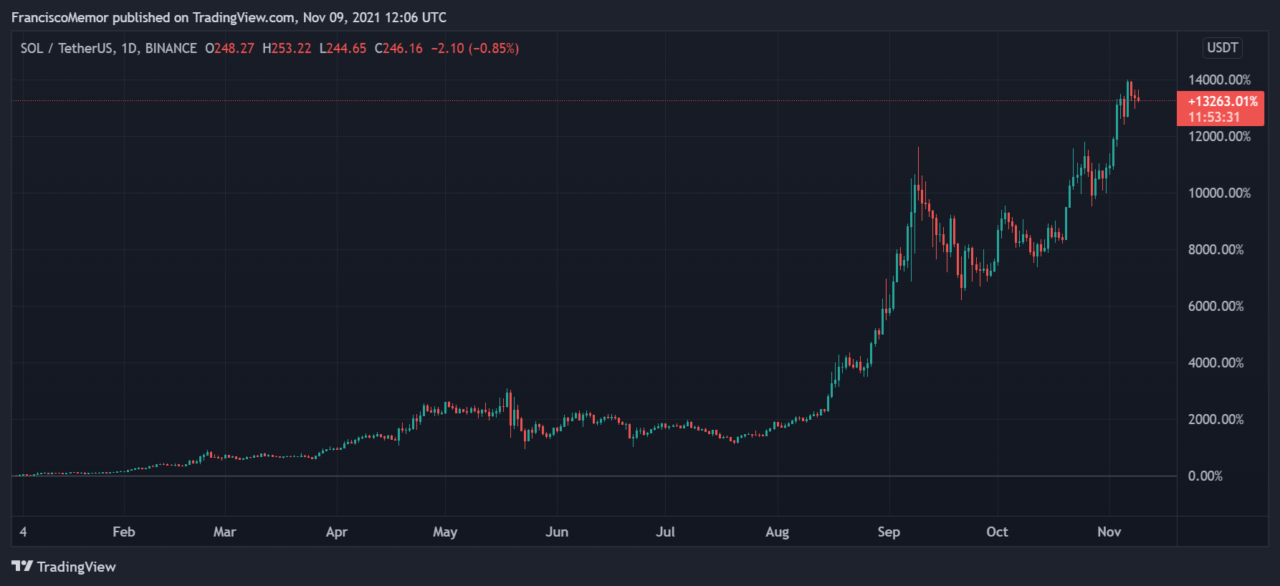The price of Solana ($SOL) could surpass the $5,000 mark by 2030 and hit $1,178 by the year 2025, according to a panel of cryptocurrency experts surveyed by Finder. The cryptocurrency has already surpassed the panel’s target for the remainder of the year, which was $235.
According to Finder, the figures come from the average forecast from a panel of 50 fintech specialists who at the time claimed the cryptocurrency could rise 16% from $202 to $235 by year-end. At the tie of writing, $SOL is trading at $245 after the cryptocurrency’s price jumped over 13,000% year-to-date.

Finder’s expert panel included notable figures from the cryptocurrency space, including the co-founder of Origin Protocol Joshua Fraser, who set a $250 price target for the end of the year based on his opinion Solana would be one of the top alternatives to Ethereum by then.
Fraser noted Solana will be the most “prominent alternative to Ethereum and Ethereum layer 2s in hosting DeFi [decentralized finance],” and added that is a “huge market to be captured” and the price could reflect that.
Gavin Smith, a general partner at Panxora Crypto, noted he believes that SOL is “one of a few smart contract-based blockchains that have the technical architecture that will be difficult for Ethereum to compete with” when it comes to transaction speeds and costs.
As for longer-term Solana price predictions Paul Levy, a Senior Lecturer at the University of Brighton, predicted by 2025 SOL will be at $3,000 based on its ability to attract new users. Levy said:
“There is a lot of potential here and I expect steady growth, but this may well come from new users rather than stealing market share,”
Cypherpunk Holdings COO Daniel Cawrey was even more bullish, claiming $20,000 by 2030. To Cawrey, Solana scales better than Ethereum and already allows users to stake their funds, implying it’s ahead of ETH.
Solana is a high-performance blockchain founded by former Qualcomm, Intel, and Dropbox engineers. It uses a delegated Proof-of-Stake (PoS) consensus algorithm and a unique method of ordering transactions to significantly improve its speed and throughput.
With the use of Proof-of-History (PoH) the Solana network can handle thousands of transactions per second. SOL itself is used to pay for transaction fees when moving funds and interacting with smart contracts on the network.
The token can also be staked as part of the network’s consensus mechanism, allowing token holders to earn staking rewards. Solana’s high transaction throughput has seen it at one point handle a peak of 400,000 transactions per second.
That demand ultimately caused the network to crash and remain offline for 17 hours. Network validators were then able to restart the network the same day it went down, although for some investors’ confidence was lost.
Finder’s expert panel was split as to whether investor confidence was lost. 40% said it was a hiccup, while another 40% said there was an inherent problem in the network. The remaining 20% were unsure.
DISCLAIMER
The views and opinions expressed by the author, or any people mentioned in this article, are for informational purposes only, and they do not constitute financial, investment, or other advice. Investing in or trading cryptoassets comes with a risk of financial loss.
IMAGE CREDIT
Featured image via Pixabay








